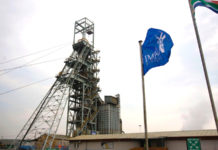
[miningmx.com] — ANGLOGOLD Ashanti viewed its exploration initiative in Eritrea as being at a similar stage as to when it moved into Colombia where it had so far delineated a resource of 12.3 million ounces of gold at the La Colosa project.
That’s according to Roric Smith, AngloGold Ashanti’s senior vice-president for global exploration, who said: “The risk is very high and we are not sure where it will all end up, but Eritrea represents a significant opportunity.’
Interviewed after the AngloGold Ashanti March quarterly presentation held in Johannesburg on Wednesday, Smith said that while AngloGold was a relative latecomer to the country, the group had immediately committed considerable resources to its exploration effort.
The attraction of Eritrea – and adjacent countries where AngloGold was also exploring such as Egypt, Saudi Arabia, Djibouti and Ethiopia – was that it lay on a geological formation called the Nubian shield.
The Nubian shield is highly prospective for gold deposits but very little exploration work has been carried out so far because of the region’s turbulent political history.
In Eritrea, AngloGold has so far completed the 10,000 line kilometre airborne electromagnetic, magnetic and radiometric survey at its Kerkasha and Akordat North exploration licences.
The preliminary results were being interpreted and surface geochemical programmes had started. Smith said exploration drilling could start in the fourth quarter of this year.
AngloGold CEO Mark Cutifani said: “Eritrea is one of the most prospective new frontiers for the gold mining industry and there is still plenty of ground available for exploration.
“We have so far picked up around 4,000sq kms of ground and have other applications in. Our strategy in the area is one of organic growth and is not an acquisition-driven strategy.’
AngloGold’s projects in this region are being carried out through a 50/50 joint venture set up in 2009 with a company called Thani Dubai Mining, which is headquartered in Dubai.
The mining pioneer in Eritrea has been Canadian junior Nevsun Resources (Nevsun) which has successfully developed the Bisha copper/gold mine there.
The first gold at Bisha was poured in January and the mine was declared to be in commercial production on February 22. At this point it was producing more than 1,000 ounces of gold a day, with the plant delivering better-than-expected recovery efficiencies.
Nevsun president Cliff Davis said on February 22: “We are very pleased to bring this spectacular deposit into production and under budget. Our success can be attributed to our staff, contractors and the unwavering support of the government of Eritrea.’
But, despite all this good news, the Nevsun share price has dropped 31% from C$7.54 at the time of the first gold pour to current levels around C$5.20.
Given the technical success of the plant and the jump in the gold price since then, the share should have not have shown such weakness.
Speculation in the share price weakness reflects investor uncertainty over the negotiations under way between Nevsun and the government of Eritrea over the payment terms and the purchase price of the 30% stake the state wants to buy in the Bisha mine.
In October 2008 John Clarke – then deputy chairperson of Nevsun – told the Nedbank African Investment Conference in Sandton that the Eritrean National Mining Corporation (Enamco) had agreed to make a payment to Nevsun equivalent to 30% of Bisha’s net present value (NPV) at the time the mine shipped its first consignment of gold.
At then ruling metal prices – gold at $800/oz; copper at $3.40 per pound and silver at $10/oz – Clarke estimated Bisha’s NPV at between $712m and $1.49bn, depending on the discount rate used.
That placed Enamco’s liability at between $214m and $447m less an initial $25m down payment already made.
The prices of gold, copper and silver have all soared since then radically boosting the net asset value of Bisha, and raising the issue of how the cash-strapped Eritrean government would find that kind of money.
Nevsun has provided no explanation for the share price drop, but the company put out an update on May 3 which stated the price to be paid by Enamco would now be finalized by June 30 “to allow the parties sufficient time to make a final determination of the purchase price’.
The statement added: “The parties have already agreed that the price will be settled from the after-tax cash flow from the mine, which will leave Nevsun with the majority of the profits until the price is fully paid. Effectively, the Enamco interest in Bisha pays for itself without a separate use of government funds.’










